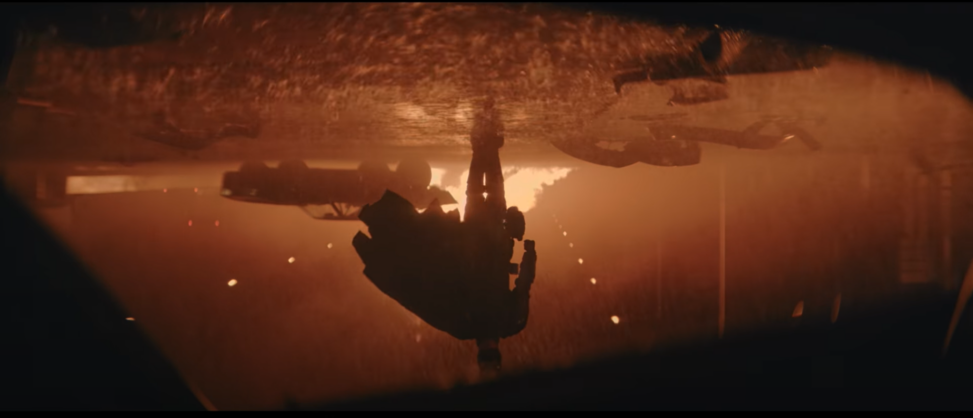The Batman (2022) is a reboot of the Batman franchise produced by DC Films. The film focuses on Batman fighting crime and hunting down the infamous serial killer, the Riddler. It achieved significant box office success, grossing over 772 million worldwide (Box Office Mojo, 2022).
This image is shot from Penguin’s POV at the end of the car chase. Batman can be seen emerging from a tower of fire and smoke, and he heads straight for Penguin, who is trapped upside down in his wrecked car. From his perspective, Batman seems invincible, vengeful and omnipotent. The mise en scene is rich with visual storytelling. It carries a heavy and vengeful tone emphasized by dramatic contrasts. The setting is dark and muted, with pouring rain and car wreckage. The fire’s orange glow contrasts sharply with the dark, wet scene. The red halo-like glow cast around Batman signifies that it blurs the lines between his vigilante justice and destruction. The camera angle is inverted and shot from a low angle to highlight Penguin’s distorted, fearful reality. Drawing elements from fascistic art, blackness shrouds the edges of Penguin’s vision as he realizes how he has been dwarfed by the gravity of his situation. He has been caught by Batman.
Within this 3-and-a-half-minute scene, there were roughly 95 cut scenes. Aggressive, discontinuous cuts bring to life the dramatic and chaotic feelings the characters experience during the chase. The scene swung the POV between Penguin and Batman to emphasize the chase’s intensity. It featured close-ups, tracking shots, and a wide shot of the crash. Camera movements ranged from shaky handheld to smooth car tracking shots. In the final shot of the action scene, the low angle of Penguin’s POV makes Batman seem larger than life. Consistent with blocking theory, the triangular flame motif surrounding Batman projects an image of aggression and danger, establishing dominance on both physical and psychological levels (Sabol, 2018). However, Penguin is trapped in his car, literally and metaphorically boxed in and helpless in what is to come (Sabol, 2018). Blocking and spatial dynamics reveal emotional and narrative subtext without explicit dialogue (Sabol, 2018). Overall, the editing was cohesive and effortless, creating an immersive viewing. Instead of focusing on the number of cut scenes, the viewer picks up on the chaos and rising tension.
Shifts in continuity alter viewers’ perception of time (Kovarski et al., 2022). Perceived scene duration is influenced by editing techniques, with longer uncut scenes perceived as longer and scenes with multiple cuts perceived as shorter (Kovarski et al., 2022). The start of the scene switches between many focal points, from different cars being slammed into, a truck flipping, close shots of the characters, to different angles of the chase. Strategic cuts created a discontinuous take that manipulated viewers’ perception of time and emotional engagement (Das, 2023). This part of the scene feels intense and hard to keep up with. In the final section of the scene, the action slows, resolving into one continuous shot. Continuity creates a comprehensive narrative flow (Ghosh, 2022). This signifies to the viewers that the narrative was not lost and that Batman still achieves his goal despite all the action.
This scene consists of stylistic violence. The emphasis is on large-scale visual effects such as collisions, explosions, and destruction rather than graphic violence. This suggests that this movie uses happy violence, a concept where characters’ violent acts are portrayed as nonconsequential and exciting. The film aestheticizes destruction as the chase laid carnage on what was once a highway.
Batman is the classic, rugged, hyper-masculine main character with few words and a dark past. He is the embodiment of traditional male character stereotypes in action films. Bruzzi (2013) argues that mise en scene is critical to portraying masculine identities through costume, lighting, and spatial positioning motifs. The car chase scene from this film has elements of darkness, central blocking, isolation, and highlights the iconic image of his mask and cape. These elements help construct Batman into a stoic, hyper-masculine, and vengeful vigilante (Bruzzi, 2013). Additionally, there is limited diversity within the film. True to classic action films, female characters have limited screen time. Catwoman was introduced as a strong female character, but was never present during important action scenes such as this one.
The Batman (2022) uses stylized violence, potentially desensitizing viewers (Huessman, 2009). The film’s violence undermines Batman’s character. He can raze his city without consequences. Such a portrayal could suggest to viewers that violence is acceptable, even commendable, potentially normalizing and glorifying its use for personal reasons.


Luis Zablah
The analysis of the movie The Batman (2022), has a very well structured and great critique diving into the film’s cinematography, editing, and their themes. It integrates our analysis of Mise en Scene very well by introducing blocking and editing techniques to support their claims. However, there are a few key areas that could have been expanded upon. The description of “The Penguin’s” perspective during the car chase is very strong analysis as it uses visual techniques to show Batman’s determination and dominance. The analysis uses great sources to explain the points made such as the use of spatial positioning in the scene. However, the analysis then touches on the “fascistic art” but doesn’t explain further; explaining these concepts could have made this analysis even greater. I believe overall, the analysis is well thought out and is well supported with the right amount of scholarly sources, as the image is well described and aligns with visual themes. However, jumping just a bit more into certain concepts and claims could have had an even stronger analysis for the masterpiece that was The Batman, when it was released back in 2022.